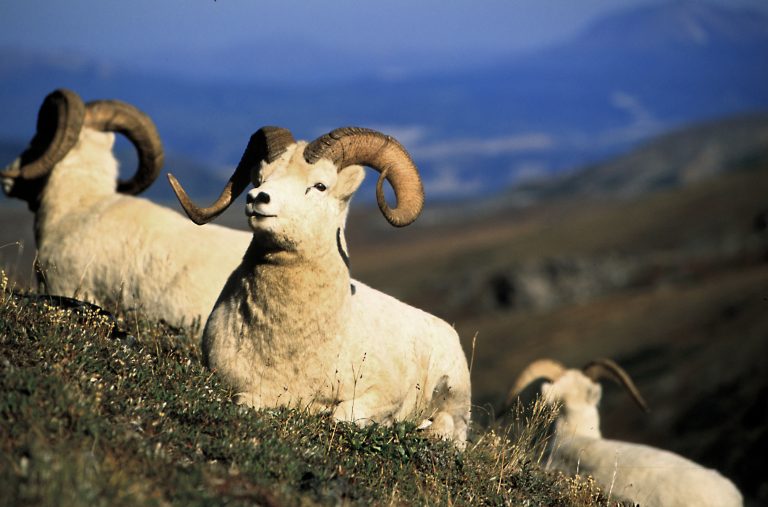More than you see, fewer than you think
peered around a boulder and there they were: a half dozen Dall rams bedded down, the nearest so close I could see my reflection in an amber eye framed by a curl of horn. They turned their heads to regard me but didn’t rise; instead, they gave what seemed to be a collective shrug as I settled in and raised my camera. I spent the next hours among them in the late August sun as they napped and grazed along the edge of that rock-strewn ridge, the air so still I could hear the echoing rush of the creek 2,000 feet below.
That afternoon, still vivid after decades, explains as well as any why I came to Alaska: to meet wild animals in big, wild country. Pretty much everyone Alaska-bound hopes, even expects, the same. No doubt they’re out there, millions of wild beings, lemmings to wolves to whales, but there’s a giant catch: the sheer size of the Great Land. Stretching 1,300 miles north to south and sprawling the equivalent of four times zones—more than a half million square miles all told—Alaska amounts to a subcontinental haystack, and its wildlife, needles scattered through all that straw. For example, 30,000 brown/grizzlies (the current estimated statewide population) may sound like a can’t-miss deal; but the math works out to less than one of those iconic bruins per 20 square miles. Besides, some species are few or nonexistent in huge areas of the state (think polar bears or muskox), and others, even if locally abundant, can be tough to spot—for example, black bears in shadowy brush or mountain goats on a snow-streaked slope. As expert wildlife spotter and photographer Tom Walker once said, there’s always more than you see but fewer than you think. So, how to improve the odds?
First, do your homework. The good news is that wildlife tends to concentrate in specific areas at specific times, and the best spots are generally known, with supporting transportation and infrastructure. If humpback whales and orcas are your grail, you’re pointed toward Southeast or southcentral coastal Alaska, summer through fall. Brown/grizzlies? Tough to beat Katmai National Park, especially during the midsummer salmon runs. One species’ local abundance usually radiates outward to include others, drawn to the same resource; where bears are eating salmon, there are higher densities of animals like mink and fox, and crowds of birds. Feeding whales often mean sea lions, gulls, and porpoises as well.

Unsurprisingly, the best wildlife-watching and photography opportunities tend to be proportionately spendy—the better the show, the higher the price tag. All-inclusive lodges or guided coastal yacht cruises typically run a thousand bucks a day on up per person. Fly-out, guided day trips, a bit less, depending on flying time. In my experience, both are usually worth the layout, both in quantity and quality. For the cost-conscious, there are definite bargains. Daily boat tours for scenic marine wildlife viewing give high bang for the buck and are family friendly. High on my personal list are the slower, day-long tour boats out of Seward plying Kenai Fiords National Park; from Juneau into Tracy Arm; and from Gustavus into Glacier Bay—and there are shorter options for folks with time constraints. Professional photographers make a habit of riding these runs and are often rewarded. Small boat trips to Anan Creek, near Wrangell, are a top bet for up-close black bear and grizzly viewing during the month-long pink salmon run; and don’t forget the caravan of buses serving Denali National Park. Though bare bones in terms of comfort and with variable viewing opportunities, they provide a unique, affordable way to spot a variety of interior Alaskan species. In my two Denali Park road trips I’ve seen caribou, moose, grizzlies, wolves, Dall sheep, and more; some as distant specks, a few near. And for the adventurous, the buses offer drop-off options for self-guided hikers and backpackers.
Which leads to the next, decidedly cheaper and independent option: self-guided wildlife viewing, pretty much anywhere you go, statewide. Even in downtown and suburban Anchorage, Fairbanks, and Juneau, prime wildlife habitat is often closer than you’d think. Moose and bears regularly slip through parks and greenways and hop fences. Get up early and stay out late to match times of peak wildlife movement; pay attention and keep your eyes peeled. That goes double out on the open road. I’ve had many memorable roadside sightings—moose, bears, beaver, lynx, marmots, snowshoe hares, coyotes, otters, Dall sheep, mountain goats, even beluga whales—because I was looking. Anytime you get a good vantage point—any river or stream crossing, marshy pond, tidal rip or open hillside is a potential hot spot—consider pulling over and taking a look. No sense hurrying past the very thing you came to see. Just looking is a major part of the adventure, an engagement with the land. Even if you spot nothing, you can bet something was there, or will be. And if you’re on a travel coach, ferry, or cruise ship, when someone else is driving, train yourself to keep looking, near to far, up and down, back and forth, for any flicker of movement, anything that stands out.
A surprising number of visitors itching to see wildlife neglect a critical piece of equipment: binoculars. Carry and use them. Yeah, it’s one more thing, but totally necessary. The best are expensive and perform accordingly; but thanks to modern computer design, a lower-end pair of surprisingly sharp, waterproof 10x40s (10 power magnification with a 40mm lens, ideal for wildlife) goes for under a hundred bucks and works fine. Practice focusing and learn to systematically cover the land or seascape before you. And once you spot something, you’ll find they’re indispensable for studying details on, say, a grazing moose a hundred yards away.
If capturing images of what you see is important, you’ll need a real camera with a minimum of a 200mm optical zoom; double or triple that is more realistic, and the sky’s the limit when it comes to spending. Cell cameras are fine for scenics, candids and close-ups, but just don’t have the telephoto reach for wildlife. I say that as a guy who loves and uses my cell camera a lot.
So, what about taking self-organized wildlife-spotting hikes—down roadside trails, along beaches or streams, across a tundra sweep or up a ridge and over the next three mountains? Safe or not? By all means go, but use your judgment and stay within your skillset. Be aware of your surroundings; pause often to look and listen. If you see a moose or bear, be cautious and try to avoid displacing it as a matter of respect. If a moose starts sauntering toward you at a purposeful walk, take it as a signal to back off; run if things feel dicey. If a bear starts appearing agitated, back away, clap and yell, but don’t run. If it starts coming, face it, make yourself big, and stand your ground. Just because a bear is seemingly ignoring you doesn’t mean all is fine. That can change in a hurry. Pepper spray, easily purchased once you arrive, is more effective than a firearm, but like a gun, takes practice. I’ve carried but never used it. Keep in mind driving in Alaska is far riskier than walking up a salmon creek lined with bears. And if you feel like you’re a bit out of your comfort zone from time to time, that’s a good thing—isn’t it?


Comments are closed.